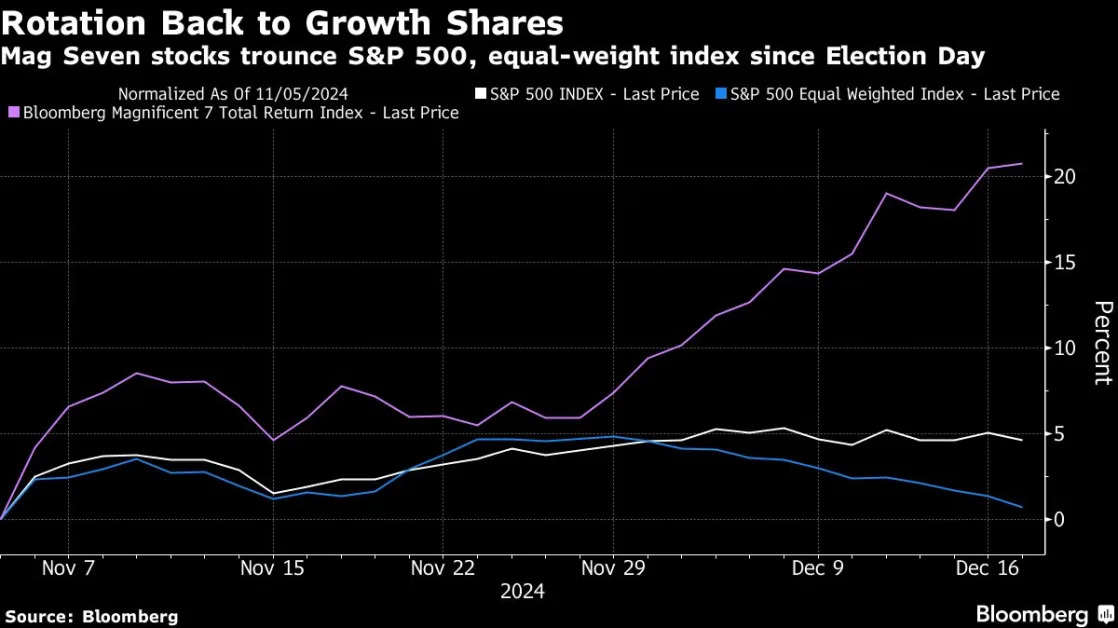(Bloomberg) -- For all the exuberance about Tesla Inc. benefiting from Donald Trump’s return to the White House, Wall Street isn’t so sure the carmaker can avoid its first annual sales decline in over a decade.
Analysts surveyed by Bloomberg are estimating the company may deliver around 510,400 vehicles in the final three months of the year. That would set a new quarterly record for Tesla, but the company would need to sell about 4,600 more cars to make good on its forecast for slight growth in 2024.
Tesla has a lot riding on the production and delivery figures it’s expected to report on Jan. 2.
The carmaker added more than $733 billion in market capitalization from Election Day through mid-December, when its valuation peaked at $1.54 trillion. While investors have been betting Musk’s emergence as the marquee donor to President-elect Trump will pay dividends for his companies, an annual sales dip could lead to some second-guessing.
Trump’s policy prescriptions are, after all, far from a slam dunk for Tesla. While a federal framework for autonomous vehicle deployment is cause for optimism, it’s not clear the company’s technology is ready. Trump’s advisers also are recommending that he repeal electric-vehicle subsidies and roll back fuel-economy and tailpipe-pollution regulations that generate significant revenue for Tesla.
“This number is a total wild card,” Gene Munster, managing partner of growth-investment firm Deepwater Asset Management, said of Tesla’s fourth-quarter deliveries. Munster is wary about Musk distancing himself from politically left-leaning consumers and embracing fans of Trump, who haven’t been buying EVs. That said, the prospect of tax credits going away soon could “really juice” Tesla’s sales, he said.
EV Slowdown
Musk has maintained throughout the year that Tesla is between two “growth waves” and repeatedly predicted that autonomy will lead to a next leg of expansion. The first touched off when the company began rolling out its most affordable EV, the Model 3 sedan, and followed that up with the smash-hit Model Y sport utility vehicle.
Whether Tesla manages to eke out any growth or not in 2024, the company lost significant momentum in the midst of a broader slowdown in the global EV market.
Even as China’s BYD Co. continued its ascent up the sales charts, the company increasingly relied on the strength of its plug-in hybrid lineup. Volkswagen AG, Mercedes-Benz Group AG and Volvo Car AB, meanwhile, were among the automakers to scale back their EV objectives for the coming years at some point in 2024.
In the US, Ford Motor Co.’s plug-in vehicle business is bracing for a $5 billion annual loss. And in Japan, a potential partnership between Honda Motor Co. and Nissan Motor Co. to jointly work on software development, batteries and other EV components has given way to considerations of a full-blown combination under a joint holding company.
Musk’s Outlook
Even against this backdrop, Musk has offered an upbeat view on 2025. When Tesla last reported quarterly earnings in October, the CEO said his best guess was that the company could increase sales by 20% to 30% next year.
That outlook rests, in part, on Tesla launching more affordable models in the first half of next year that the company has yet to identify.
Chris McNally, an analyst at Evercore ISI, wrote in a report to clients Monday that his best guess is Tesla will offer new variants of the Model 3 and Y that are $4,000 to $5,000 cheaper through an improved electrical architecture and “de-contenting,” a reference to using lower-cost parts or removing certain components or features.
Tesla has already gotten a jump on its affordability drive by closing the year with a flood of deals, ranging from cut-rate financing to years of free charging and cheaper leases.
Musk’s 2025 sales growth forecast “is likely to prove aggressive,” according to Garrett Nelson, an analyst at CFRA Research.
“We see headwinds facing EV sales from the possible combination of a stronger dollar, higher domestic oil production from easing regulations, and lower oil prices,” Nelson wrote in a Dec. 2 report. “After a year in which Tesla’s vehicle sales growth will likely be flattish, we see its volumes growing only 10%-15% in 2025, or only half as strong as its guidance.”





